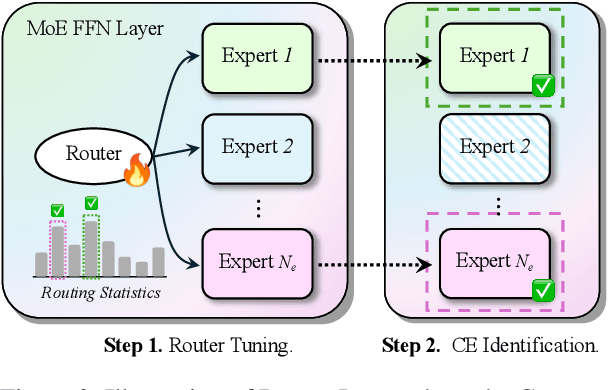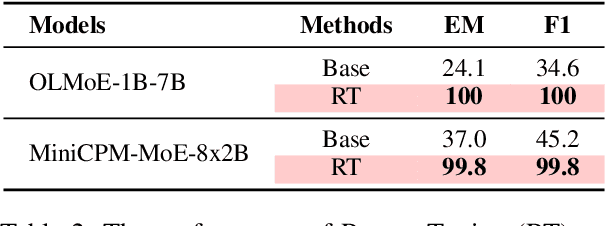Zilong Zheng
UltraVoice: Scaling Fine-Grained Style-Controlled Speech Conversations for Spoken Dialogue Models
Oct 26, 2025Abstract:Spoken dialogue models currently lack the ability for fine-grained speech style control, a critical capability for human-like interaction that is often overlooked in favor of purely functional capabilities like reasoning and question answering. To address this limitation, we introduce UltraVoice, the first large-scale speech dialogue dataset engineered for multiple fine-grained speech style control. Encompassing over 830 hours of speech dialogues, UltraVoice provides instructions across six key speech stylistic dimensions: emotion, speed, volume, accent, language, and composite styles. Fine-tuning leading models such as SLAM-Omni and VocalNet on UltraVoice significantly enhances their fine-grained speech stylistic controllability without degrading core conversational abilities. Specifically, our fine-tuned models achieve improvements of 29.12-42.33% in Mean Opinion Score (MOS) and 14.61-40.09 percentage points in Instruction Following Rate (IFR) on multi-dimensional control tasks designed in the UltraVoice. Moreover, on the URO-Bench benchmark, our fine-tuned models demonstrate substantial gains in core understanding, reasoning, and conversational abilities, with average improvements of +10.84% on the Basic setting and +7.87% on the Pro setting. Furthermore, the dataset's utility extends to training controllable Text-to-Speech (TTS) models, underscoring its high quality and broad applicability for expressive speech synthesis. The complete dataset and model checkpoints are available at: https://github.com/bigai-nlco/UltraVoice.
Understanding and Leveraging the Expert Specialization of Context Faithfulness in Mixture-of-Experts LLMs
Aug 27, 2025



Abstract:Context faithfulness is essential for reliable reasoning in context-dependent scenarios. However, large language models often struggle to ground their outputs in the provided context, resulting in irrelevant responses. Inspired by the emergent expert specialization observed in mixture-of-experts architectures, this work investigates whether certain experts exhibit specialization in context utilization, offering a potential pathway toward targeted optimization for improved context faithfulness. To explore this, we propose Router Lens, a method that accurately identifies context-faithful experts. Our analysis reveals that these experts progressively amplify attention to relevant contextual information, thereby enhancing context grounding. Building on this insight, we introduce Context-faithful Expert Fine-Tuning (CEFT), a lightweight optimization approach that selectively fine-tunes context-faithful experts. Experiments across a wide range of benchmarks and models demonstrate that CEFT matches or surpasses the performance of full fine-tuning while being significantly more efficient.
In-situ Value-aligned Human-Robot Interactions with Physical Constraints
Aug 11, 2025Abstract:Equipped with Large Language Models (LLMs), human-centered robots are now capable of performing a wide range of tasks that were previously deemed challenging or unattainable. However, merely completing tasks is insufficient for cognitive robots, who should learn and apply human preferences to future scenarios. In this work, we propose a framework that combines human preferences with physical constraints, requiring robots to complete tasks while considering both. Firstly, we developed a benchmark of everyday household activities, which are often evaluated based on specific preferences. We then introduced In-Context Learning from Human Feedback (ICLHF), where human feedback comes from direct instructions and adjustments made intentionally or unintentionally in daily life. Extensive sets of experiments, testing the ICLHF to generate task plans and balance physical constraints with preferences, have demonstrated the efficiency of our approach.
TongSearch-QR: Reinforced Query Reasoning for Retrieval
Jun 16, 2025



Abstract:Traditional information retrieval (IR) methods excel at textual and semantic matching but struggle in reasoning-intensive retrieval tasks that require multi-hop inference or complex semantic understanding between queries and documents. One promising solution is to explicitly rewrite or augment queries using large language models (LLMs) to elicit reasoning-relevant content prior to retrieval. However, the widespread use of large-scale language models like GPT-4 or LLaMA3-70B remains impractical due to their high inference cost and limited deployability in real-world systems. In this work, we introduce TongSearch QR (Previously Known as "TongSearch Reasoner"), a family of small-scale language models for query reasoning and rewriting in reasoning-intensive retrieval. With a novel semi-rule-based reward function, we employ reinforcement learning approaches enabling smaller language models, e,g, Qwen2.5-7B-Instruct and Qwen2.5-1.5B-Instruct, to achieve query reasoning performance rivaling large-scale language models without their prohibitive inference costs. Experiment results on BRIGHT benchmark show that with BM25 as retrievers, both TongSearch QR-7B and TongSearch QR-1.5B models significantly outperform existing baselines, including prompt-based query reasoners and some latest dense retrievers trained for reasoning-intensive retrieval tasks, offering superior adaptability for real-world deployment.
RuleReasoner: Reinforced Rule-based Reasoning via Domain-aware Dynamic Sampling
Jun 10, 2025Abstract:Rule-based reasoning has been acknowledged as one of the fundamental problems in reasoning, while deviations in rule formats, types, and complexity in real-world applications pose severe challenges. Recent studies have shown that large reasoning models (LRMs) have remarkable reasoning capabilities, and their performance is substantially enhanced by reinforcement learning (RL). However, it remains an open question whether small reasoning models (SRMs) can learn rule-based reasoning effectively with robust generalization across diverse tasks and domains. To address this, we introduce Reinforced Rule-based Reasoning, a.k.a. RuleReasoner, a simple yet effective method to conduct rule-based reasoning via a wide collection of curated tasks and a novel domain-aware dynamic sampling approach. Specifically, RuleReasoner resamples each training batch by updating the sampling weights of different domains based on historical rewards. This facilitates domain augmentation and flexible online learning schedules for RL, obviating the need for pre-hoc human-engineered mix-training recipes used in existing methods. Empirical evaluations on in-distribution (ID) and out-of-distribution (OOD) benchmarks reveal that RuleReasoner outperforms frontier LRMs by a significant margin ($\Delta$4.1% average points on eight ID tasks and $\Delta$10.4% average points on three OOD tasks over OpenAI-o1). Notably, our approach also exhibits higher computational efficiency compared to prior dynamic sampling methods for RL.
When Large Multimodal Models Confront Evolving Knowledge:Challenges and Pathways
May 30, 2025Abstract:Large language/multimodal models (LLMs/LMMs) store extensive pre-trained knowledge but struggle to maintain consistency with real-world updates, making it difficult to avoid catastrophic forgetting while acquiring evolving knowledge. Previous work focused on constructing textual knowledge datasets and exploring knowledge injection in LLMs, lacking exploration of multimodal evolving knowledge injection in LMMs. To address this, we propose the EVOKE benchmark to evaluate LMMs' ability to inject multimodal evolving knowledge in real-world scenarios. Meanwhile, a comprehensive evaluation of multimodal evolving knowledge injection revealed two challenges: (1) Existing knowledge injection methods perform terribly on evolving knowledge. (2) Supervised fine-tuning causes catastrophic forgetting, particularly instruction following ability is severely compromised. Additionally, we provide pathways and find that: (1) Text knowledge augmentation during the training phase improves performance, while image augmentation cannot achieve it. (2) Continual learning methods, especially Replay and MoELoRA, effectively mitigate forgetting. Our findings indicate that current knowledge injection methods have many limitations on evolving knowledge, which motivates further research on more efficient and stable knowledge injection methods.
Discrete Markov Bridge
May 26, 2025Abstract:Discrete diffusion has recently emerged as a promising paradigm in discrete data modeling. However, existing methods typically rely on a fixed rate transition matrix during training, which not only limits the expressiveness of latent representations, a fundamental strength of variational methods, but also constrains the overall design space. To address these limitations, we propose Discrete Markov Bridge, a novel framework specifically designed for discrete representation learning. Our approach is built upon two key components: Matrix Learning and Score Learning. We conduct a rigorous theoretical analysis, establishing formal performance guarantees for Matrix Learning and proving the convergence of the overall framework. Furthermore, we analyze the space complexity of our method, addressing practical constraints identified in prior studies. Extensive empirical evaluations validate the effectiveness of the proposed Discrete Markov Bridge, which achieves an Evidence Lower Bound (ELBO) of 1.38 on the Text8 dataset, outperforming established baselines. Moreover, the proposed model demonstrates competitive performance on the CIFAR-10 dataset, achieving results comparable to those obtained by image-specific generation approaches.
EuroCon: Benchmarking Parliament Deliberation for Political Consensus Finding
May 26, 2025Abstract:Achieving political consensus is crucial yet challenging for the effective functioning of social governance. However, although frontier AI systems represented by large language models (LLMs) have developed rapidly in recent years, their capabilities on this scope are still understudied. In this paper, we introduce EuroCon, a novel benchmark constructed from 2,225 high-quality deliberation records of the European Parliament over 13 years, ranging from 2009 to 2022, to evaluate the ability of LLMs to reach political consensus among divergent party positions across diverse parliament settings. Specifically, EuroCon incorporates four factors to build each simulated parliament setting: specific political issues, political goals, participating parties, and power structures based on seat distribution. We also develop an evaluation framework for EuroCon to simulate real voting outcomes in different parliament settings, assessing whether LLM-generated resolutions meet predefined political goals. Our experimental results demonstrate that even state-of-the-art models remain undersatisfied with complex tasks like passing resolutions by a two-thirds majority and addressing security issues, while revealing some common strategies LLMs use to find consensus under different power structures, such as prioritizing the stance of the dominant party, highlighting EuroCon's promise as an effective platform for studying LLMs' ability to find political consensus.
ReflectEvo: Improving Meta Introspection of Small LLMs by Learning Self-Reflection
May 22, 2025Abstract:We present a novel pipeline, ReflectEvo, to demonstrate that small language models (SLMs) can enhance meta introspection through reflection learning. This process iteratively generates self-reflection for self-training, fostering a continuous and self-evolving process. Leveraging this pipeline, we construct ReflectEvo-460k, a large-scale, comprehensive, self-generated reflection dataset with broadened instructions and diverse multi-domain tasks. Building upon this dataset, we demonstrate the effectiveness of reflection learning to improve SLMs' reasoning abilities using SFT and DPO with remarkable performance, substantially boosting Llama-3 from 52.4% to 71.2% and Mistral from 44.4% to 71.1%. It validates that ReflectEvo can rival or even surpass the reasoning capability of the three prominent open-sourced models on BIG-bench without distillation from superior models or fine-grained human annotation. We further conduct a deeper analysis of the high quality of self-generated reflections and their impact on error localization and correction. Our work highlights the potential of continuously enhancing the reasoning performance of SLMs through iterative reflection learning in the long run.
Seek in the Dark: Reasoning via Test-Time Instance-Level Policy Gradient in Latent Space
May 19, 2025Abstract:Reasoning ability, a core component of human intelligence, continues to pose a significant challenge for Large Language Models (LLMs) in the pursuit of AGI. Although model performance has improved under the training scaling law, significant challenges remain, particularly with respect to training algorithms, such as catastrophic forgetting, and the limited availability of novel training data. As an alternative, test-time scaling enhances reasoning performance by increasing test-time computation without parameter updating. Unlike prior methods in this paradigm focused on token space, we propose leveraging latent space for more effective reasoning and better adherence to the test-time scaling law. We introduce LatentSeek, a novel framework that enhances LLM reasoning through Test-Time Instance-level Adaptation (TTIA) within the model's latent space. Specifically, LatentSeek leverages policy gradient to iteratively update latent representations, guided by self-generated reward signals. LatentSeek is evaluated on a range of reasoning benchmarks, including GSM8K, MATH-500, and AIME2024, across multiple LLM architectures. Results show that LatentSeek consistently outperforms strong baselines, such as Chain-of-Thought prompting and fine-tuning-based methods. Furthermore, our analysis demonstrates that LatentSeek is highly efficient, typically converging within a few iterations for problems of average complexity, while also benefiting from additional iterations, thereby highlighting the potential of test-time scaling in the latent space. These findings position LatentSeek as a lightweight, scalable, and effective solution for enhancing the reasoning capabilities of LLMs.
 Add to Chrome
Add to Chrome Add to Firefox
Add to Firefox Add to Edge
Add to Edge